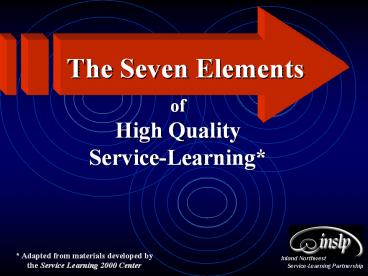of High Quality Service-Learning* - PowerPoint PPT Presentation
1 / 9
Title:
of High Quality Service-Learning*
Description:
The Seven Elements of High Quality Service-Learning* * Adapted from materials developed by the Service Learning 2000 Center Inland Northwest Service-Learning Partnership – PowerPoint PPT presentation
Number of Views:39
Avg rating:3.0/5.0
Title: of High Quality Service-Learning*
1
of High Quality Service-Learning
The Seven Elements
Adapted from materials developed by the Service
Learning 2000 Center
Inland Northwest Service-Learning
Partnership
2
1. Integrated Learning2. High Quality
Service3. Collaboration4. Student Voice5.
Civic Responsibility6. Reflection7. Evaluation
Inland Northwest Service-Learning
Partnership
3
1. Integrated Learning
- The service-learning project has clearly
articulated knowledge, skill or value goals that
arise from broader classroom and school goals. - The service informs the academic learning
content, and the academic learning content
informs the service. - Life skills learned outside the classroom are
integrated back into classroom learning.
Unrelated learning
Integrated learning
Inland Northwest Service-Learning
Partnership
4
2. High-Quality Service
- The service responds to an actual community
need that is recognized (and expressed) by the
community. - The service is age-appropriate and
well-organized. - The service is designed to achieve significant
benefits for students and community.
Low Service
High Service
Inland Northwest Service-Learning
Partnership
5
3. Collaboration
- The service-learning project is a collaboration
among as many of these partners as is feasible
students, parents, community-based organizations,
school administrators, teachers, and recipients
of service. - All partners benefit from the project and
contribute to its planning and implementation.
Placements
Partnerships
Inland Northwest Service-Learning
Partnership
6
4. Student Voice
- Students participate actively in
- choosing and planning the service project
- planning and implementing the reflection
sessions, evaluation,
and celebration and - taking on roles and tasks that are appropriate
to their ages.
Passive Recipients
Active Participants
Inland Northwest Service-Learning
Partnership
7
5. Civic Responsibility
- The service-learning project promotes student
responsibility to care for others and to
contribute to the community. - By participating in the service-learning
project, students understand how they can impact
their community.
Individual Gains
Community Benefits
Inland Northwest Service-Learning
Partnership
8
6. Reflection
- Reflection establishes connections between
student service experiences and the academic
curriculum. - Reflection occurs before, during and after the
service-learning project phase.
Disconnected Activity
Reflected Activity
Inland Northwest Service-Learning
Partnership
9
7. Evaluation
- All the partners, especially students, are
involved in evaluating the service-learning
project. - The evaluation seeks to measure progress toward
the learning and service goals of the project.
Ambiguous Results
Observable Outcomes
Inland Northwest Service-Learning
Partnership































